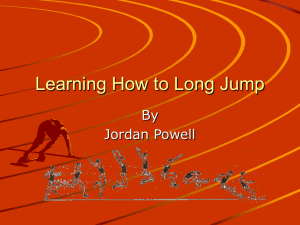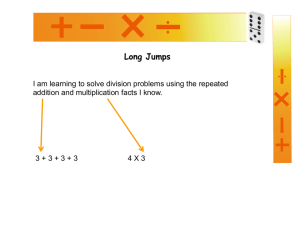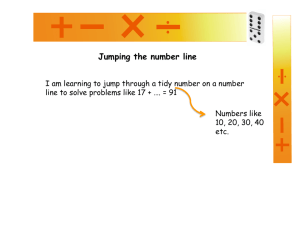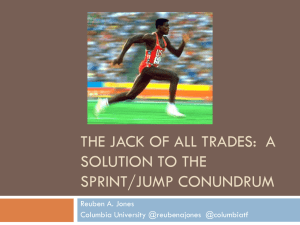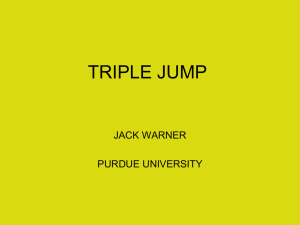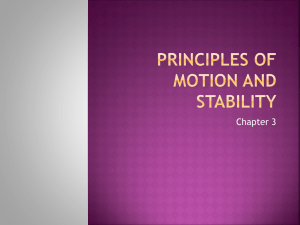Teaching Change of Direction
advertisement
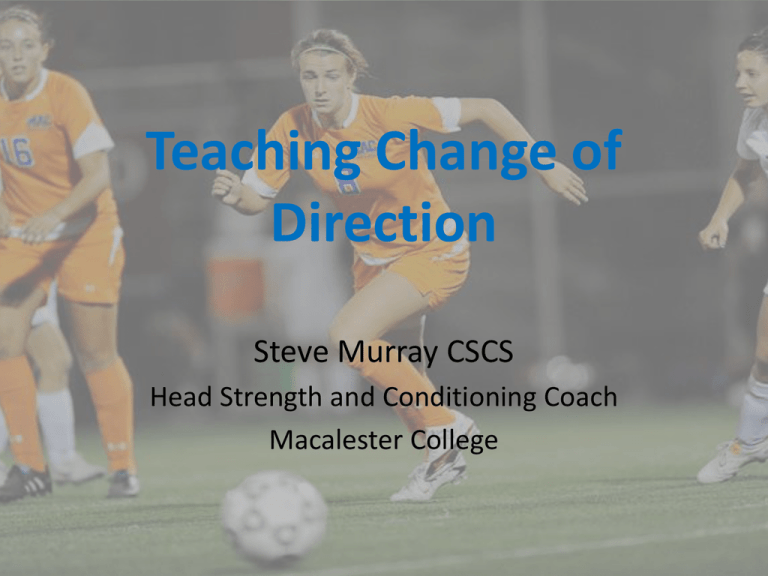
Teaching Change of Direction Steve Murray CSCS Head Strength and Conditioning Coach Macalester College Change of Direction • Technique • Functional Strength • Muscle ability • Reaction Technique • Foot Placement – Feet Slightly wider then shoulder width – Weight on Balls of your feet – Circle of Balance • Athletic Stance – Load Your Hips • Sit your butt back • Do not allow your knees over your toes – Posture • Shoulders, knees , and ball of foot should be lined up – Shin Angle • Steps – Avoid pivoting, jumping, extra steps – Deceleration and Acceleration Muscle Ability • Functional Strength – Ability to hold and control your body in an athletic stance • Lower body and core strength • Power – Ability to call up that strength quickly • Reaction Strength – Stretch shorting cycle • Ability to stop the eccentric load and use the built up energy in the concentric movement Teaching Change of Direction • • • • Holds Movement into a hold Hold with a movement Movement into a movement • Reaction HOLDS • Designed to teach landing mechanics and proper posture • Holds are performed for 3 – 60 sec. • Longer holds in the start – Need to start with fundamental strength before progressing from holds – Longer holds in the start allow you to create the muscle memory in a fatigued state – Also more opportunity to hammer home technique and form – Progression • DL Holds, SL Holds, Positive Shin Angle, Forward Push Back, Backwards Push Forward Movement into a Hold • • • • • Once they are able to properly perform the holds you will start creating ways to increase force as they get into the holds Opportunity to work the eccentric portion of the stretch shortening cycle Important to emphasis “sticking the landing” The holds are 3 to 5 sec. Progression – Start with small simple movements. • Easy for athletes to progress themselves through these basic movements • Vertical jump with hold, broad jump with hold, box jumps, vertical jump with SL hold, broad jump with SL hold, lateral jumps with SL hold – Move into complex movements • Ski hops with hold, forward run w/ hold, backward run with hold, run into lateral hold, bounding with hold, 45 degree jumps into holds • Progress from set stopping points to stopping on command or visual Movement into a Movement • Opportunity to start incorporating the full stretch shortening cycle into your movements • It is very important that they have progressed through the first 2 stages and are able to properly hold and stick the landing in both single and double leg exercises • Progression – Jump into Jump • Double Jump(vertical), Continuous Broad Jumps, Continuous Single Leg Forward Jumps, Standing Triple Jump, – Jump into Jump Changing Direction • Continuous Lateral Bounds, Forward Jump into Backwards Push Off, Backwards Jump into Forward Push Off, 45 Degree Bounds, Forward Jump into Lateral Push Off, Lateral Push Off into Forward jump Movement into a Movement • Run into Change of Direction – Start with a jog and build up to a sprint – Run into Bound • Run into Push Back, Run into Lateral Bound, Run into 45 Degree Bound Cut Back, Run into Side Step – Run into Run • Single Movement Cutback – Work all angles and directions • Cone Drills – Start with single plan cone drills and progress to multi plan cone drills Reaction – Without a predetermined stopping point, the stress on the joints and ligaments is increased greatly during change of direction • To stay injury free an athlete must have the mechanics, strength and technique mastered – Progression • Run into Bound with voice command – Ex. Run forward and on your command Lateral Bound back • Run into Run Single Movement with voice command – Ex. Run forward and on your command cut at 45 degree angle • Run into Run Multiple Movements with voice command – Single plan » 5 Movement Reaction – Multiple Plans » 5 Cone Reaction Reaction – Progression Cont. • Partner Single Movement Reaction from set position – Pro Agility Single Movement Reaction • Partner Single Movement Reaction with predetermined cutting point – Pro Agility Double Movement Reaction • Partner Multi Movement Reaction with predetermined cutting points – 4 Corner Partner Reaction • Partner Reaction single plan – Partner 5 Movement Reaction • Partner Reaction with different foot patterns – Partner 5 Movement Reaction with Foot Movement Information • Steve Murray – smurray@macalester.edu – 651-696-6748 • Fitness at Macalester – http://athletics.macalester.edu/sports/2008/11/5 /GEN_1105084519.aspx?tab=fitnessatmacalester • http://www.youtube.com – Channel: Macalesterfitness

